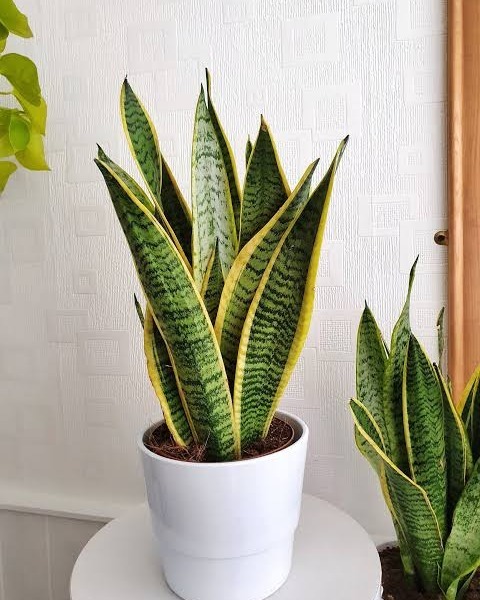While having plants at home, indoors or outdoors, is nothing new, their popularity has grown tremendously in recent years. Many people keep plants today; I bet you have some in your home.
Plants are timeless and beautiful and come in various types and forms. However, while you have plenty of options, selecting the right plants is important, especially with pets at home. Snake plants are among the most sought-after succulents, but can you plant them if you have dogs at home?
Are snake plants toxic to dogs? Yes, snake plants (Sansevieria) are considered toxic to dogs. They contain certain chemical compounds that can be harmful to dogs if Ingested. The toxic components are saponins and other compounds, which can cause gastrointestinal upset, vomiting, diarrhea, and in some cases, drooling and lethargy in dogs.
That’s not all about snake plants and dogs, so keep reading.
Are Snake Plants Toxic to Dogs?
Snake plants are mild to moderately toxic to dogs. Due to this, severe poisoning cases are rare, and most dogs recover with proper veterinary care and supportive treatment.
So, the good news is, the odds of your dog succumbing from ingesting this succulent are minimal, but you must keep an eye on them regardless.
Why are snake plants toxic to dogs anyway?
Snake plant, aka Mother-in-Law’s tongue has naturally occurring chemicals called saponins that serve various functions in plants, including defense against pests and pathogens.
However, while beneficial to the snake plant, the opposite is true for dogs. The saponins present can cause gastrointestinal irritation in your dogs.
These irritants can disrupt the normal digestive system’s functioning, causing symptoms such as drooling, vomiting, and diarrhea. Snake plants are also toxic to other animals, like cats and horses.
Also Read:
- How To Make Snake Plants Grow Taller And Straight
- How to Care for Indoor Snake Plants
- Why is my snake plant drooping?
Symptoms of Snake Plant Poisoning in Dogs
The symptoms a dog exhibits if they ingest a snake plant, vary based on the amount consumed and the individual dog. Therefore, how your dog reacts to eating this plant may differ from other dogs. However, the common symptoms include:
1. Gastrointestinal Upset
This is a common symptom seen in dogs after ingesting snake plants. The saponins in snake plants can irritate the gastrointestinal tract, leading to various digestive issues. However, how do you tell your dog has gastrointestinal upset?
- Vomiting: Your dog can vomit after ingesting snake plants, with the vomit containing partially digested food, bile, or foamy material.
- Diarrhea: The ingestion of snake plants can result in loose, watery, or even bloody stools. Your dog may defecate more frequently than usual.
- Excessive drooling: If you have a dog breed like Bulldog, Newfoundland, and Saint Benard, you are used to drooling. However, your dog may salivate excessively as a result of oral irritation caused by the plant’s toxins. This can lead to noticeable drooling or foaming at the mouth.
- Abdominal discomfort: Dogs experiencing gastrointestinal upset may exhibit abdominal discomfort signs, like pacing, restlessness, or whining. They may also show discomfort signs when you touch their abdomen.
2. Loss of Appetite
Gastrointestinal tract inflammation and irritation caused by saponins can lead to a reduced desire for food and reluctance to eat. Your dog will also feel nauseous and uncomfortable, making them lose interest in food or associate eating with negative feelings, decreasing appetite.
3. Oral Irritation
The saponins can also irritate your dog’s mouth and throat if they ingest snake plants, causing pain and discomfort. A dog suffering from oral irritation produces lots of saliva and drools excessively.
You may also see your dog pawing at their mouth or rubbing their face against objects in an attempt to alleviate the discomfort.
They may even paw at their face or rub it against furniture or the ground to relieve the irritation. If you inspect their gums or tongue, you may notice redness, swelling, or inflammation.
4. Lethargy
Unless your dog is naturally a couch potato, you will suspect something is different when they appear weak, tired, or less active than usual. Snake plant consumption causes lethargy in dogs.
Lethargic dogs may exhibit increased drowsiness and spend more time sleeping or lying down than usual.
They may also show a lack of enthusiasm or reluctance to engage in exercise or playtime.
5. Changes In Behavior Or Coordination
The toxins in snake plants can affect a dog’s nervous system leading to behavioral and coordination changes. These symptoms are less common than gastrointestinal upset or lethargy but nonetheless possible.
So, your dog may appear disoriented, showing difficulty recognizing familiar surroundings or finding their way around. You may observe stumbling, unsteady gait, or difficulty maintaining balance. Also, they can become restless, less responsive, agitated, or exhibit repetitive movements.
What To Do If Your Dog Eats Snake Plant?
Your dog accidentally found access to your snake plant and ingested it. How do you help them recover from the plant’s effects? Take the actions below.
a) Remove The Snake Plant
Keep your dog from consuming more of the snake plant by removing its fallen bits and putting the succulent where your canine cannot reach it.
b) Assess The Situation
To help your vet assess the risk and provide the best way to help your dog, try to determine when and how much your dog ingested the snake plant. So, monitor your dog closely for symptoms of snake plant ingestion and note down any observed symptoms or changes in behavior.
c) Give Your Dog A Bath
The sap from the snake plant may still be on your dog’s paws, skin, and fur, so give your dog a bath with warm, soapy water. In addition, clean your dog’s mouth using clean water to keep them from ingesting any more of the snake plant still in their mouth.
d) Contact Your Veterinarian
Reach out to your vet for guidance and to discuss the situation. Provide them with details about your dog’s ingestion of the snake plant, including the approximate ingestion time, the quantity consumed if known, and any observed behavioral change or symptoms.
Your vet will tell you what to do based on the specific situation. For instance, they may ask you to bring your dog in for an examination, provide at-home care instructions, or advise on whether additional treatment is necessary.
e) Monitor Your Dog
Your dog will need close monitoring up to 48 hours after ingestion. Keep an eye out for distress signs or unusual behavior in your dog. Also, keep a record of any observed symptoms, their duration, and their severity, noting the time of onset and the progression of any symptoms.
You’ll also need to track your dog’s eating and drinking habits. Furthermore, pay attention to changes in the color, consistency, or frequency of your dog’s urine and stool.
f) Don’t Induce Vomiting
Unless the vet gives the go-ahead, don’t induce vomiting in your dog. Inducing vomiting is appropriate in some instances of ingestion, but it is not always safe or effective. However, inducing vomiting is necessary or beneficial when it comes to snake plant ingestion by dogs.
Ways To Keep Your Dog Safe If You Have A Snake Plant
If you decide to plant a snake plant with dogs at home, you will want to adopt ways to keep your pet safe and also the plant. The safety measures will help you minimize the risk of your dog coming into contact with the snake plant and reduce the likelihood of ingestion or any associated health issues.
1. Keep The Plant Out Of Reach
Place the snake plant where your dog cannot access it. Elevated plant stands, or hanging baskets are excellent choices as they keep the plant elevated and away from your dog’s reach.
2. Create Physical Barriers
Keep your snake plants separate from your dog using baby gates or pet barriers. This will help restrict access to rooms or areas with the snake plant and help prevent your dog from coming into direct contact with the plant.
3. Train Your Dog
Discourage your dog from approaching or interacting with the snake plant by teaching them commands like “off” or “leave it”. Consistent training and reinforcement can help establish boundaries and prevent your dog from showing interest in the plant.
4. Consider Alternative Plant Options
Another way to keep your dog from ingesting a snake plant is not planting this succulent in the first place. Instead, consider choosing pet-safe plants as alternatives.
There are plenty of pet-friendly houseplants available that can add greenery to your home without posing a risk to your dog.
These include Baby Tears, Parlor Palm, African Violet, Spider Plant, and Haworthia.
5. Supervise Your Dog
When in the same room as the snake plant, keep an eye on your dog to ensure they don’t attempt to chew on or ingest the plant.
6. Provide Suitable Chewing Alternatives
Offer appropriate chew toys and provide mental and physical stimulation to keep your dog occupied and deter them from chewing on the snake plant. This will keep them away from your snake plants when they get bored or relieve teething discomfort.
Summary
Snake plants and dogs can co-exist in your home, provided you keep your pet from ingesting them. However, with snake plants’ mild to moderate toxicity levels in dogs, they should fully recover if they ingest it; just ensure you act swiftly.

Hey there, fellow plant enthusiasts! I’m Rachel, the green-thumbed writer behind Rooted In Garden. With a deep-rooted love for all things botanical, I’ve made it my mission to help you cultivate a thriving collection of houseplants. As a devoted plant parent myself, I understand the joys and challenges that come with nurturing these leafy wonders. Whether you’re a succulent aficionado, an orchid enthusiast, or simply adore all potted flora, join me on this journey as we explore the secrets to growing and caring for our beloved green companions. Together, let’s create a flourishing oasis indoors.


